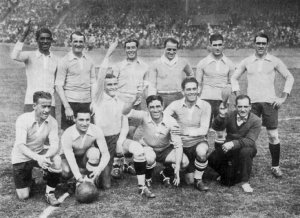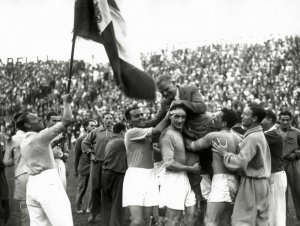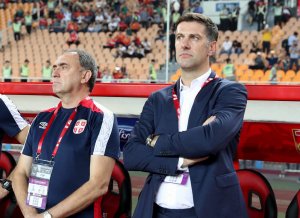Initial systems of play didn’t exactly guarantee a spectacle on the pitch. The Scottish model 2-2-6 as an answer to the English 1-1-8 formation required the keeper to kick the ball towards the other half of the pitch and eight forwards in chaotic duels against the entire opposing team. Needless to say, such tactics didn’t produce many goals, chances or huge excitement.
‘Kick and run’ football was finished by 1925 with the introduction of the Sheffield Rules allowing for modified offside rules to expand horizons.

Uruguay national team during the 1928 Olympics | photo credit: commons.wikimedia.org
Promptly, first serious models of play were born – ‘the Pyramid’ and ‘the System.’ The former, better known as ‘WW system’, amounted to basic formation with two fullbacks in front of the goalkeeper, three centre-halfs in the middle and five forwards (two wingers, two halves and a striker).
Blackburn won five FA Cups playing in this system, while Genoa ruled the Italian football and Uruguay won two Olympic golds (1924 and 1928).
With ‘the Method’ as the legal successor to ‘the Pyramid’, Vittorio Pozzo triumphed in two World Cups (1934 and 1938) and the legendary Hugo Meisl created the blueprint for the Austrian ‘Wunderteam.’
Observed tactically, ‘the Method’ looked like 2-3-2-3 and, compared to ‘the Pyramid’, this system offered straightforward defensive organization and quicker ball movement in the middle of the pitch. Juventus won five consecutive titles in the early thirties playing with this system.
Here, we are interested in the other system. It was simply called ‘the System’ or ‘WM’ model of play which with time evolved into 3-4-3. Defensive midfielder (centre-half) was tucked in between the two fullbacks playing as a classic sweeper. His main responsibility was to track the opposition striker and organize the defensive phase of play.
Difference between the two systems that marked one footballing era should be obvious. ‘The Method’ relied on resolute defending and deadly counter-attacks, while ‘the System’ favored passing, technique and possession.

Vitorio Poco celebrating a victory with players | photo credit: commons.wikipedia.org
Vittorio Pozzo in Italy and Herbert Chapman in England represented the ideal interpreters of ‘the System,’ a predecessor to modern 3-4-3, while ‘Grande Torino’ was the team that perfected this style of play. Italy would have never been considered a ‘cattenacco’ nation had there not been for the Superga air disaster that took out one of the most talented generations in the history of European football.
The modern variant 3-4-3 emerged in the late nineties as a revolutionary response to the classic system 4-4-2.
Although many experts consider it a very offensive style of play, its application is completely different from that. We begin with the assumption that the team with three defenders protecting the space in the last third will create surplus thus making the job easier against a couple of opposition strikers. Moreover, Antonio Conte applied the same approach last season when switching the system rejuvenated Chelsea allowing for their title run:
‘We started the season with another system because the idea in my mind was that I wanted to play with the 4-2-4, and then we switched with 4-3-3 and we played also in the same way like last year, 4-2-3-1,’ the Italian remembers his tactical wandering at the beginning of his Chelsea career. ‘But I noticed in some circumstances we didn’t have the right balance because when you concede more goals than your opponent and even more chances to score a goal, it is never a good thing. For this reason, we switched to the new system of 3-4-3 and I think this is a good fit for our squad because also we have the strikers adapted for this system’.
You can play efficient and attractive football using any system. The key is the right mentality and intensity of work. Complexities of 3-4-3 system require absolute dedication from the entire playing and coaching staff.
The team must function like a music orchestra where each person plays a different instrument, yet everyone plays from the same sheet. You achieve this with didactic approach and situational training, without neglecting individual qualities of each player.
‘Following the detailed analysis, Muslin arrived to a conclusion that 3-4-3 is the perfect system to make the most of individual qualities of Serbian players,’ says Slobodan Bobe Pavković, a well-known football analyst and a member of Serbia coaching staff. ‘You need to understand that this system isn’t inflexible and due to overlapping and transition play it can morph into other variants with ease. Most common are 3-4-2-1 when attacking and 5-4-1 when our opposition has the ball.’

Slobodan Pavković and Mladen Krstajić | photo credit: FA Serbia
Slobodan Pavković maintained his position with the Serbia coaching staff after Slavoljub Muslin was sacked and together with the caretaker manager Mladen Krstajić he took part in changing the system of play for a couple of friendly matches in the Far East:
‘I was shocked to see Marcelo Lippi come out in 3-4-3 formation in a friendly match against our national team. Listen, that’s absurd. He knew we had played in the qualifiers using this system and assumed we wouldn’t change anything. Despite this, he chose to ‘mirror’ our system, even though it is well-understood when the two mirror systems clash you get “one on one” in every zone of the pitch which means the team with more individual quality will emerge victorious. Had we been looking to get a result, we’d have sticked to our original model and possibly got a more convincing win.
’
First things first, a 3-4-3 formation guarantees easier transition against the teams who press since the keeper has one extra option for a pass compared to the formation with two centre-backs.
‘In this system, there are five key positions on the pitch. The Centre-back, the right midfielder, the central midfielder, the winger and the striker or “the target man.” You need to have polyvalent players in these positions. If any of the five players isn’t capable of delivering a good performance in at least two positions then you have a problem. A good example of this is Dušan Tadić. At the beginning of the World Cup qualifiers he was exceptional playing as a winger. He would cut to the middle to set up chances and his finishing was impeccable. Once his form had dropped, our system stopped working and Serbia struggled towards the end of the qualifying campaign.’
None of the formations require strict disposition of lines across the pitch. A manager’s ability, as well as the quality of the team, are reflected in how skillful are they when making corrections in response to what’s happening on the pitch. Only the top class teams are able to change the system at a given moment during the match without abandoning their philosophy and tactical aspect.
‘I call it ‘the art of adjustment,’ which is very important in the build-up to every match. For example, we were trying to work out tactics for the match against Wales who play in 3-4-2-1 formation, with Aaron Ramsey and Gareth Bale tucked in behind Sam Vokes. Then we receive the team sheet and understand Coleman opted for two strikers. Alright, no big deal. Playing with 3-4-3 you’re not inferior in any formation line. We have three defenders playing against their two strikers, in the middle we’re evenly matched and up front we have three attackers who can make a difference with their individual qualities. Still, our dip in form started against Wales in Belgrade. If the opponent is playing with five in the back accompanied by four defensive-minded midfielders, then your system 3-4-3 is in big trouble. The space is closed and you’re forced to think of alternatives. At this stage, Dušan Tadić started drifting into midfield, which was a wrong thing to do, absolutely. As an attacker, he drifted out of the game and lost his function in the team. Filip Kostić then had to cover for Tadić in that position so what happened was a complete breakdown in our positional play which we weren’t able to control for the rest of the match. It’s fair to say it remained like that until the end of the qualifying campaign.’
Each system takes time in terms of results. For example, Vladimir Weiss abruptly made a decision to switch to 3-4-3 formation for the match against Moldavia and was undone. Players need to breathe as one and be impeccable with respect to tactical demands.

Branislav Ivanović against Republic of Ireland | photo credit: Serbia FA
‘Our backline was rather interesting. We had Branislav Ivanović who was actively involved in starting attacks and even finishing them. You can see that in the match against Georgia when he ventured forward with the ball and initiated the attack for Aleksandar Prijović’s winner. Against Ireland, he had most of the ball in their half, which says a lot. Opponents typically don’t expect the center-back on the right side of the defensive line to be the catalyst of play. In Ivanović we had an extra man in attacking phase. He would switch up the play with diagonal or through balls which made him one of our most creative players. When you’ve got Tadić looking for space on on the right between their center-back and their fullback or between the lines, with Antonio Rukavina overlapping, you get an unstoppable triangle. In our first match against Ireland we had a similar situation, albeit on the left with Filip Mladenović, Jagoš Vuković and Filip Kostić.’
Upon analyzing the play of our national team while looking for the most efficient solutions, Pavković focused on Conte’s vision which won Chelsea the league last season:

Chelsea – Premier league champions in season 2016/17
‘It was a carbon copy of what we were doing in our qualifying campaign. I also fancied Pochettino’s alternative playing with 3-5-1-1 with Tottenham. With Harry Kane, Heung-Min Son and Christian Eriksen they really looked like us in the attacking phase. For me, the perfect application of 3-4-3 is what Arsene Wenger did in the North London Derby back in November. He discovered an ideal combination with Lacazette as the finisher of play created by Mesut Ozil and Alexis Sanchez. With Hector Bellerin wide, and Aaron Ramsey in the middle this looked attractive and efficient at the same time.’
Antonio Rukavina’s play was often a subject of discussion among the experts on the way to Russia. The footballer who is usually on the bench at Villareal was one of the more consistent performers under Slavoljub Muslin.
‘Perhaps someone will not agree, but for me Antonio Rukavina was our key player throughout the qualifying campaign. If you watch all nine matches he’s played in, you will notice he had an important role in the final third. As soon as we get to the final third, he would be there on the right flank, ready to receive the ball and make a cross. Like the classic wingers of the past… His movement without the ball, him finding space, making late runs… The problem with him was of other nature. For example, in Cardiff he made eight unsuccessful crosses. Only the ninth found its target and Mitrović headed it in. He wasn’t less defensive compared to Mijat Gaćinović in the same position against Moldavia in Belgrade. This is why I don’t share the opinion we were defensively oriented in qualifiers with Kolarov and Rukavina. Granted, we weren’t ultra-offensive either like Belgium with Carrasco and Meunier in the same positions, but good enough to allow for offensive style. If we had Branislav Ivanović in place of Rukavina, that could be considered defensive.’
In the defensive phase, the most important role in 3-4-3 formation is reserved for the central defensive player in a defensive trio. He should not only possess a footballing brain (creativity, heading, one on one), but he should also possess a certain type of character. A midfield general, if you will.

Franz Beckenbauer in action for Germany | Photo credit: commons.wikimedia.org
‘The players we had in this position were Matija Nastasić and Nikola Maksimović. Those playing in this position must communicate with the goalkeeper at all times, start attacking play and make the most important decisions. He decides whether we play a high line, withdraw in our own half, or play an offside trap. Therefore, this footballer carries a lot of responsibility and represents the modern version of the sweeper patented in the seventies by Kaiser Franz (Beckenbauer).’
In attacking positions, managers prefer inverted wingers, or wingers who are “wrong-footed” and play on the side of their weak foot. You don’t expect them to cross the ball (this becomes the job of wide midfielders), but they do cut inside, shoot with their strong foot or make the final pass to your striker. If everyone does their job, 3-4-3 offers many advantages.
‘Once left and right midfielder advance, centre-backs disperse and three attackers are in the opposition half where they usually occupy as high as four defensive players, then you have 8 vs 6 in your half. With the right disposition of players you create a network that allows you to advance with the ball with ease and build attacks. This didn’t work well for us since our positional play when starting attacks was flawed. We didn’t insist on ideal positional arrangement. We would lose possession quickly even though we had players who are technically gifted in the middle.’
In case you are still baffled how a Newcastle sub Aleksandar Mitrović became Serbia’s top scorer in the qualifiers, you need to pay good attention to the characteristics of ideal type of forward in 3-4-3 system. You need a robust type of central forward. A pivot who can play with his back to goal, receive the ball and hold it up to allow forward movement for the rest of the lines. This player provides ‘depth’ and is good in the air so you could have a point of reference when playing long ball from the back, and at the same time a target man after successful wide play.
Application of system is one, while cooperation among players is something completely different. If the latter fails, your system doesn’t have a purpose. This was the reason for our debacle in Vienna.
‘I still can’t explain what happened there. It’s a mystery. To put it simply, our team selection was misguided.’
This observation ‘our team selection was misguided’ from our match in Austria refers predominantly to starting Stefan Mitrović. This was one of the biggest mistakes Slavoljub Muslin made in the qualifying campaign. Starting a player of questionable quality ahead of Duško Tošić who plays well in the Champions League and has more experience in playing with Ivanović and Nastasić, could have had catastrophic consequences for Serbian football in the long run. To illustrate how important it is to have defensive player who know each other well, just look at the country that will not take part in the World Cup finals after 60 years:
‘Just remember how BBC worked ever so well in Juventus, and how they’ve been struggling since Bonucci signed for AC Milan,’ explains Bobe Pavković.
The biggest shortcoming of the 3-4-3 system is the lack of players in the middle. If your opponent is playing with 4-3-3 or 4-2-3-1, by definition they have a spare man in the zone crucial for the balance of play.

Dušan Tadić in training for Serbia national team | Photo credit: Serbia FA
‘We were faced with this problem in both matches against Georgia. In Tbilisi, Nemanja Matić and Luka Milivojević had a fierce battle with Jaba Kankava and Valeriane Gvilia, while their defensive midfielder Nika Kvekveskiri had complete freedom. As a consequence, they managed to score against us and create two or three brilliant chances to close the match. It happened again in the first half in Belgrade. Every system needs to be flexible and only then, can it be efficient. Had we rotated well, we’d have had ‘3 vs 3’ making the job easier for Nemanja Gudelj and Nemanja Matić. When playing against 4-3-3, our wide player (Kolarov) would often stay isolated in ‘one vs two’ situation, providing our opponent with huge space for combination play and giving goal-scoring opportunities. The idea was to have Kostić close down their right back when they’re attacking and Stefan Mitrović to look for space between the two centre-backs, while Tadić would then drop to the middle to play in defensive phase as a midfielder.’
By staying true to its ‘genes,’ 3-4-3 should keep offensive properties of its predecessor ‘the System’ and provide the team with superiority on the pitch. Serbia qualified for the World Cup finals by winning their group, but they were far from brilliant and didn’t look like a team with the ability to achieve something at the tournament.
‘We lacked more synchronicity in the middle of the pitch. And maybe we needed the other central midfielder to be explicitly offensive. In this position, you can’t play simple passes as a midfielder. You’re expected to take part in attacking, get involved in creating opportunities, and, if chance falls, make a threatening shot or final pass.’
This lead us to the key question. How come this system couldn’t allow for Sergej Milinković-Savić? Isn’t the versatile Lazio player ideal suit for the ‘explicitly offensive playmaker?’
‘If I’m not mistaken, Austria played just one match in 3-4-3 formation, against Moldavia in Vienna. Stefan Isanker played as an enforcer, while Zlatko Junuzović was the other central midfielder. Therefore, someone who plays in their standard 4-2-3-1 formation as a “number 10” just behind their striker. He did a fabulous job, I think he set up both goals. It is clear Sergej Milinković-Savić possesses outstanding qualities, but Muslin believed other players are better suited for this system.’
It is strange that a player of his potential couldn’t find space in the thoughts of Serbia’s former manager. This shouldn’t be a mystery, it is clear there had been some kind of a conflict that was never made public. If there’s one player with characteristics that don’t fit the 3-4-3 system, then that player is Adem Ljajić who received another call up to the national team towards the end of qualifying campaign.
Even without Milinković-Savić, Serbia still qualified to the World Cup finals so hats off to the manager and his staff. Just ask Ventura, Advocaat, Schevchenko or Martin O’Neill if they would have accepted ‘ugly football’ in exchange for the Russian visa. Their response should make you realise the magnitude and significance of Serbia’s accomplishment.

